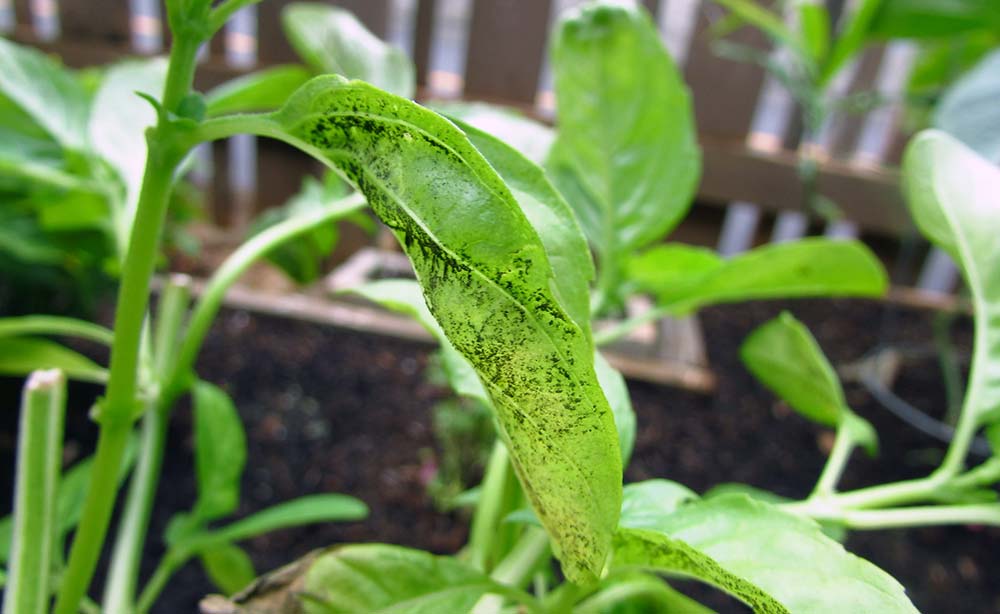Downy mildew is a disease caused by a variety of water molds, primarily affecting grapes, brassica (broccoli, cabbage, cauliflower, kale, turnip, etc.), vine-borne vegetables, and a variety of species of ornamental flowers. In California, it is particularly notorious for its impact on grape and spinach production. Affected plants develop light patches on the tops of leaves, and fuzzy growths on the undersides, which gradually expand until the leaf turns brown and dies.
The symptoms of downy mildew are largely confined to leaf surfaces but can have a profound impact on crop production.
Downy mildew—which is entirely unrelated to powdery mildew—causes yellow or white lesions on leaf surfaces, which expand and gradually turn brown. On the undersides of affected leaves, white, gray, bluish, or even purple fuzzy growths will form. Eventually, leaves dry out and die, regardless of the availability of water. Branches with many infected leaves may warp and eventually die as well.

Misdiagnosis is quite common with downy mildew, as the expression of symptoms can vary significantly depending on the plant species, and even between cultivars of a species. Symptoms vary most on the upper sides of affected leaves. that may be yellow and resemble symptoms of chlorosis, or can be quite dull and blend in with the normal coloration. In serious cases, leaves may curl and exhibit deformed growth like that seen in some types of blight, and leaf surfaces may develop a white, dusty coating.
Because the variation in symptom appearance, the growth of fungal colonies on the undersides of leaves is generally the telltale symptom of downy mildew. However, particularly severe infections can produce dense growths that look more like powdery mildew or gray mold. Before starting a treatment plan, it’s advisable to have a tissue sample tested to definitively diagnose the disease.
Downy mildew is caused by several different species of water molds in the genuses Peronospora and Plasmopara.
The most notorious water mold species to cause downy mildew is likely Plasmopara viticola, which infects grapes and may well be the most financially devastating grapevine disease on the planet. It has been known to reduce the output of France’s famed vineyards by as much as 50%.
However, there are dozens if not hundreds of organisms which cause downy mildew. Some of these are generalists which can infect a variety of plant species in a genus, or even an entire family. For instance, Peronospora lamii, which favors mint as a host, is also known to cause downy mildew in other plants in the family Lamiaceae, such as basil, salvia, and nettles. But other such pathogens may target only a single plant genus, or even species, as with Plasmopara viticola and its fondness for grapevines.

Some of the more notable downy mildew-causing water molds and their respective hosts include Pseudoperonospora cubensis (cucurbits), Pseudoperonospora humuli (hops), Peronospora manshurica (soybeans), Peronospora effuse (spinach), and Peronospora sparsa (roses). In addition to P. viticola, another specialist which often plagues California farmers is Peronospora farinosa f. sp. spinaciae, which inflicts a deeply destructive form of downy mildew on spinach plants—and which can maintain a toehold even when crops are rotated out and soils sanitized by infecting the weed Chenopodium (goosefoot).
But regardless of the causal species, the lifecycle of downy mildew is largely the same. The spores bearing the infectious organisms are readily transported via wind. Thus, even in locations where conditions get so cold that downy mildew spores cannot overwinter in the soil or plant debris, warmer southern regions serve as an incubator for the disease. In the spring, winds from the south carry dormant spores north, depositing them on soil, plant surfaces, and plant debris. However, much of California remains warm enough for spores to overwinter in place.
Spores remain inactive until temperatures reach between 58 and 72 degrees, and conditions are adequately humid. Then spores resting on leaf surfaces—or inside of plant tissues—are activated, producing mycelia which allow them to tap into nearby plant tissues for food.
The disease suspends development when conditions dry out or temperatures are above or below optimal conditions. This means that the disease goes through cycles of growth and transmission in the early evening through late morning hours. Sporangiophores grow on leaf surfaces, which spawn zoospores which swim across moist leaf surfaces, spreading the disease within a single plant or to adjacent plants.
The time it takes a single zoospore to colonize a plant surface, reproduce, and generate new zoospores or dormant spores (oospores) is anywhere from 4 to 10 days, depending on the favorability of conditions. When the weather turns cool, dormant spores remain encased in leaf litter and other decaying plant matter until the weather warms again, and the cycle resumes.
Controlling downy mildew requires a multi-prong strategy: avoiding prolonged wet conditions, careful sanitation, and fungicidal treatments.
Farmers can successfully prevent or reduce the occurrence of downy mildew by ensuring that their fields and crops are not allowed to remain moist for long periods of time. The organisms which produce downy mildew are universally water-loving by nature. They require moist conditions to germinate, grow, spawn new spores, and swim to new plants and spread infection.
Growers should water crops during early morning hours, so that plant surfaces dry out within a few hours as the day warms. Better yet, switching from overhead irrigation to soaker hoses or other ground-level irrigation methods will ensure that leaf surfaces remain dry entirely. Keep under-canopy areas well-pruned, as these regions are heavily shaded and can harbor moisture throughout the day. Make sure plants are well-spaced to ensure proper airflow as well.
In California’s mild climate, plant debris can easily harbor dormant spores between growing seasons. Thus, all dead plant debris should be removed from plants, the ground under plants, and between plant rows. Any plants that are seriously infected with downy mildew should be removed and destroyed, as eliminating the disease may take long enough to allow the infected plant to spread it.
There are dozens of fungicidal treatments available which are suitable for both preventative and post-infection treatments. Traditional copper-based foliar sprays are the most commonly used pre-infection fungicide, though they do have some effectiveness even after symptoms appear. However, for maximum efficiency, a systemic or penetrative fungicide should be used after infection occurs. But these treatments tend to be extremely costly, and it can be difficult to find a fungicide that is effective in eradicating the specific organism responsible for the outbreak of downy mildew. Thus, it behooves growers to take a proactive, preventative approach to controlling downy mildew.
Many growers opt to select plant cultivars advertised as having natural resistance to downy mildew. However, this resistance often fails as pathogens mutate and adapt. In addition, we have found that resistant cultivars often become susceptible when growing conditions and/or nutritional supplementation is subpar. This means that a previously successful plant grown in conditions that are frequently moist and waterlogged, or which are only fertilized using nitrogen-based products, will often ‘lose’ their resistance and succumb to downy mildew.
Fusion 360 has always taken the approach that supplying superior nutrition to crops will go a long way towards remedying the incidence of downy mildew and other diseases. By placing about 60% to 75% of the emphasis on superior nutrition, and the remaining balance on fungicidal treatments, growers can give plants the heightened health they need to fight off infection.
Downy mildew is caused by opportunistic pathogens that are always present in the soil. But infections only occur when plants have insufficient nutrient uptake, resulting in their immune systems being depressed, leaving them unable fight off these invaders. Elevating plants’ metabolisms with applications of nutritional soil and/or a foliar program reduces the ability of downy mildew pathogens to infect crops.
We invite growers struggling with downy mildew to contact Fusion 360 for assistance in developing a nutritional regimen to compliment and strengthen your existing control and eradication efforts.




